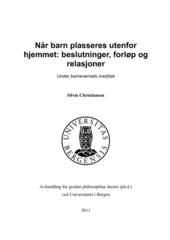| dc.contributor.author | Christiansen, Øivin | |
| dc.date.accessioned | 2013-07-11T08:05:36Z | |
| dc.date.available | 2013-07-11T08:05:36Z | |
| dc.date.issued | 2011-12-07 | eng |
| dc.identifier.isbn | 978-82-308-1887-9 (print version) | eng |
| dc.identifier.uri | https://hdl.handle.net/1956/6795 | |
| dc.description.abstract | The aim of this thesis is to contribute to the knowledge about out-of-home care for children under the auspices of the Child Welfare authorities. Removing children and placing them in care constitutes one of the strongest public interventions in families. This makes it crucial to gain empirical knowledge of i) why and how Child Welfare Services reach decisions to remove the children; ii) the placement trajectories they experience while in care, and; iii) the relationships they form with their carers. The thesis is conducted within a critical realist and street-level bureaucracy perspective. The analyses are presented in three separate papers which are all based on interview data from the longitudinal and multi-informant study ‘The Norwegian Longitudinal Study on Out-of-Home Care’ (Barn som blir plassert utenfor hjemmet – risiko og utvikling). A national sample of 109 children, aged 6-12 years and recently placed out-of-home constitute the initial sample in this project. Paper 1 is based on interviews with the 109 children’s social workers. The interviews were carried out within a few months after the placements. The social workers’ accounts revealed a decision-making process which took place within a context of continued concerns for the children and ongoing interactions between the social workers and the children’s parents. The interactions were influenced by the contradictory position of the social workers: supporting the parents so that they are capable of taking care of their children, while at the same time assessing whether that care is adequate. In most cases a triggering and legitimizing factor was necessary for the out-of-home placement to take place. Paper 2 examines the placement trajectories of 70 of the 109 children who remained in care for at least four years. Data included interviews with the children, their parents and their social workers carried out 7-8 years after the initial placement, supplemented with social worker interviews at earlier stages. The majority of children experienced 1-3 moves after the initial placement. For most children these moves were from temporary placements leading to more stable living in foster care. However, a substantial minority experienced foster care breakdowns. Although social workers, children and parents acknowledged the foster carers efforts in offering the children safe and stable placements, they also placed the main responsibility for breakdowns on them, even if they regarded other factors as important too. Paper 3 explores the relationships between the 43 foster children and their foster families who had stayed in long term foster care. The data material is made up of Interviews with the children, their foster carers, parents and social workers, carried out 7-8 years after the initial placement. . The over all frame of reference in the informants’ accounts were the life in “ordinary families” and relations like most parents and children. The foster families had provided the children with a secure environment as well as an experience of being part of the family. Most children also had a sense of belonging to their birth families. Nearly all were likely to stay with their foster carers beyond their 18th birthday and both parts anticipated future contact. However, a number of foster carers expressed ambivalence and cautious expectations about the character of their future contact, due to their understanding that the nature of the relationship depended on the children’s own choice. The thesis indicates that parents and parenting are in the centre of attention in cases concerning out-of-home care. This applies both before the placement when parenting is carried out by the children’s birth parents and is subject to continuous and longterm assessment and intervention efforts, and during the placement when parenting is accomplished by foster carers. Although parenting plays a vital role in children's development and wellbeing, closer attention should in addition be paid to other important factors and actors. In particular, there is a need to acknowledge the children’s point of view, their experiences, motives and wishes. A more child-centred and comprehensive approach would contribute to a more reliable basis for decision making and to more stability in care arrangements. Further, it might ensure children with long lasting supportive relationships after leaving care. | en_US |
| dc.language.iso | nob | eng |
| dc.publisher | The University of Bergen | eng |
| dc.relation.haspart | Paper 1: Christiansen, Ø. & Anderssen, N. (2010). From concerned to convinced: reaching decisions about out-of-home care in Norwegian Child Welfare Services. Child & Family Social Work, 15(1), 31-40. Full-text not available in BORA due to publisher restrictions. The published version is available at: <a href="http://dx.doi.org/10.1111/j.1365-2206.2009.00635.x" target="blank">http://dx.doi.org/10.1111/j.1365-2206.2009.00635.x</a> | eng |
| dc.relation.haspart | Paper 2: Christiansen, Ø., Havik, T., & Anderssen, N. (2010). Arranging stability for children in long-term out-of-home care. Children and Youth Services Review, 32(7), 913-921. Full-text not available in BORA due to publisher restrictions. The published version is available at: <a href="http://dx.doi.org/10.1016/j.childyouth.2010.03.002" target="blank">http://dx.doi.org/10.1016/j.childyouth.2010.03.002 </a> | eng |
| dc.relation.haspart | Paper 3: Christiansen, Ø., Havnen, Karen J. S., Havik, T., & Andersen, N. Cautious belonging – relationships in long-term foster care. British Journal of Social Work, 43(4), 720-738. Full-text not available in BORA due to publisher restrictions. The published version is available at: <a href="http://dx.doi.org/10.1093/bjsw/bcr198" target="blank">http://dx.doi.org/10.1093/bjsw/bcr198 </a> | eng |
| dc.title | Når barn plasseres utenfor hjemmet: beslutninger, forløp og relasjoner. Under barnevernets (ved)tak | eng |
| dc.type | Doctoral thesis | |
| dc.rights.holder | Copyright the author. All rights reserved | |

